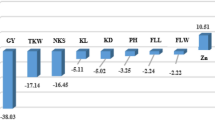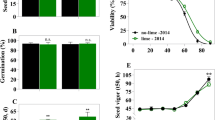Abstract
THE aim in producing Triticale was to combine the hardiness and tolerance of low soil fertility of rye with the superior yield and bread-making qualities of wheat1, but there has been little experimental evidence that triticales carry the desirable characteristics from rye2. We present here evidence of the tolerance of triticale to low concentrations of available copper in soil, a condition widely associated with poor sandy soils in Australia3. Such soils may contain enough total copper for tens of thousands of crops but it is relatively unavailable to widely grown cultivars of wheat, oats and barley. In contrast, rye rarely shows a response to copper on these soils4–7.
This is a preview of subscription content, access via your institution
Access options
Subscribe to this journal
Receive 51 print issues and online access
$199.00 per year
only $3.90 per issue
Buy this article
- Purchase on Springer Link
- Instant access to full article PDF
Prices may be subject to local taxes which are calculated during checkout
Similar content being viewed by others
References
Tsen, Cho. C. (ed.) Triticale: First Man-made Cereal (American Association of Cereal Chemists, St. Paul, Minnesota, 1974).
Kiss, A. in Triticale, 41–50 (International Development Research Centre, Ottawa, 1974).
King, P. M. thesis, Univ. Adelaide (1974).
Riceman, D. S. & Donald, C. M. Pamphlet 78 (Council for Scientific and Industrial Research, Melbourne, Australia, 1938).
Nambiar, E. K. S. Aust. J. agric. Res. 27, 453–463 (1976).
Smilde, K. W. & Henkens, Ch. H. Neth. J. agric. Sci. 15, 249–258 (1967).
Riceman, D. S., Donald, C. M. & Evans, S. T. Pamphlet 96 (Council for Scientific and Industrial Research, Melbourne, Australia, 1940).
Driscoll, C. J. & Sears, E. R. Agron. Abstr. 6 (1971).
Merker, A. Hereditas 80, 41–52 (1975).
Graham, R. D. Nature, 254, 514–515 (1975).
Piper, C. S. & Walkley, B. A. J. Council Sci. indust. Res. 16, 217–234 (1943).
Nuttonson, M. Y. Rye–Climate Relationships (American Institute of Crop Ecology, Washington DC, 1958).
Weiss, M. G. Genetics 28, 253–268 (1943).
Wall, J. R. & Andrus, C. F. Am. J. Bot. 49, 758–762 (1962).
Graham, R. D. Aust. J. Pl. Physiol. 3, 229–236 (1976).
Author information
Authors and Affiliations
Rights and permissions
About this article
Cite this article
GRAHAM, R. Tolerance of Triticale, wheat and rye to copper deficiency. Nature 271, 542–543 (1978). https://doi.org/10.1038/271542a0
Received:
Accepted:
Published:
Issue Date:
DOI: https://doi.org/10.1038/271542a0
Comments
By submitting a comment you agree to abide by our Terms and Community Guidelines. If you find something abusive or that does not comply with our terms or guidelines please flag it as inappropriate.



